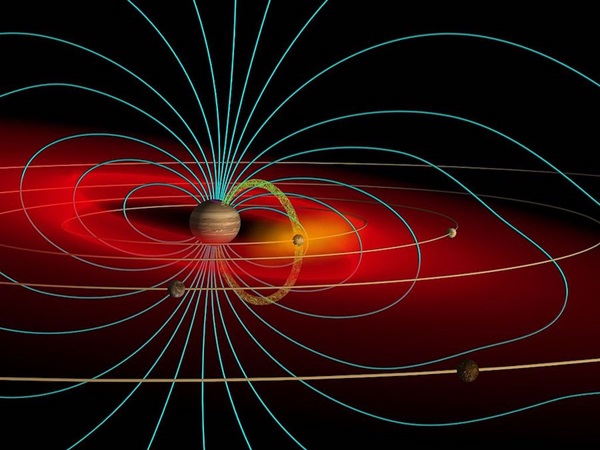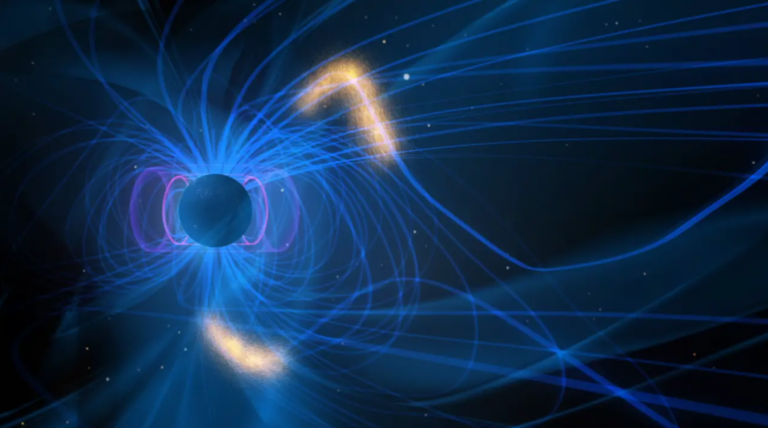Astronomers have found that this planet with free-range has a magnetic field that is 4 million times more powerful than that of Earth
A unique and mysterious planet, untethered to any star, meanders through the vast expanse of the Milky Way, a mere 20 light-years away from our Sun. Recently unveiled in The Astrophysical Journal, this enigmatic wanderer possesses an incredibly powerful magnetic field, surpassing that of Earth by a staggering 4 million times. What’s even more astonishing is that this exoplanet showcases breathtaking auroras, outshining even the beauty of our own northern lights.
These groundbreaking findings, made possible by the National Science Foundation’s Karl G. Jansky Very Large Array (VLA), not only represent the first-ever radio observations of a planet-sized entity outside our solar system but also mark a significant milestone in our ability to measure the magnetic field of such a celestial body.
Examining SIMP
The peculiar and unattached entity, SIMP J01365663+0933473 (hereafter referred to as SIMP for brevity), was first discovered in 2016. Initially categorized as a brown dwarf, a celestial body too large to be a planet yet too small to be a star, subsequent research in the previous year indicated that SIMP, with a mass equivalent to 12.7 times that of Jupiter and a radius 1.2 times larger, meets the criteria of a planet—albeit a massive one.
Melodie Kao from Arizona State University, who led the recent study on SIMP, stated, “This object straddles the boundary between a planet and a brown dwarf, or ‘failed star,’ and presents surprises that could potentially enhance our understanding of magnetic phenomena on both stellar bodies and planets.”
SIMP exhibits a notably high temperature for a planet: surpassing 1,500 degrees Fahrenheit (825 Celsius). To put this into perspective, Venus, the hottest planet in our solar system, maintains an average temperature of around 875 F (470 C), while the Sun, a relatively mild and cool star, has a surface temperature of about 10,000 F (5,500 C). Nevertheless, it is important to note that Venus primarily receives its heat from the Sun. In contrast, as SIMP orbits no star, its warmth must originate from its formation around 200 million years ago. Consequently, this colossal planet will gradually lose its heat over time.
Unmatched Magnetism
Based on the most recent research, SIMP not only possesses immense size in comparison to other planets but also contains a magnetic field that is millions of times stronger than Earth’s. This magnetic field is responsible for the stunning light shows seen on SIMP, with auroras appearing in a unique way when compared to those found on our planet.
Jupiter possesses an incredibly powerful magnetic field, which is about 20,000 times stronger than Earth’s. This magnetic field gives rise to stunningly bright auroras on the planet. These auroras occur when electrically charged particles accelerate along Jupiter’s magnetic field lines and collide with atoms in its upper atmosphere. The speed at which these particles travel is approximately 3,000 miles (5,000 kilometers) per second.
On Earth, a similar process occurs to create the northern and southern lights. However, the charged particles responsible for Earth’s auroras mainly come from the Sun in the form of solar wind. In contrast, on Jupiter, these particles mostly originate from its moon Io rather than the solar wind. Since SIMP does not have a star bombarding it with solar wind like Earth, scientists suggest that SIMP’s auroras may resemble those of Jupiter, indicating the potential presence of a moon.
Magnetic Revelation

To summarise: SIMP appears to be a colossal, magnetic exoplanet adrift without a star, possibly accompanied by a moon, generating splendid auroras while traversing the Milky Way.
Impressive indeed. But how does this intriguing discovery contribute to astronomers’ understanding of the universe?
Kao elaborated, “This particular entity is enthralling because studying its magnetic dynamo mechanisms can furnish us with fresh insights into how similar mechanisms operate in extrasolar planets. We believe these mechanisms can operate not only in brown dwarfs but also in both gas giant and terrestrial planets.”
In its essence, SIMP offers a promise to advance astronomers’ understanding of magnetic field generation in exoplanets. However, there is more to it!
Co-author Gregg Hallinan of Caltech pointed out that detecting SIMP J01365663+0933473 with the VLA through its auroral radio emission also indicates a potential new method for identifying exoplanets, including the mysterious rogue ones that do not orbit a parent star.
Therefore, SIMP not only emerges as a highly intriguing entity on its own but also as a pathway to future discoveries related to exoplanetary magnetic fields and auroras, aiding in the search for exoplanets that prefer solitude.
Do not forget to share your opinion with us to provide you with the best posts !




0 Comments